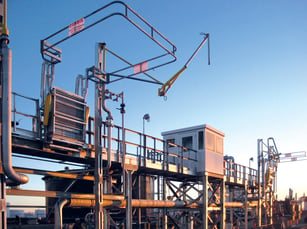 To keep your products and people moving efficiently, you need the right loading equipment for the job. While hoses are popular for loading and unloading liquids, they pose serious safety risks to your workers.
To keep your products and people moving efficiently, you need the right loading equipment for the job. While hoses are popular for loading and unloading liquids, they pose serious safety risks to your workers.When moving liquids in and out of rail cars, a safer rail safety solution is to use a loading arm.
In some instances, hoses are necessary for moving liquids. However, many facilities rely on hoses in circumstances where a loading arm would provide greater production efficiency while also benefiting workplace safety.
Here are five ways loading arms improve safety and efficiency at your rail site:
1. Loading Arms Are Better For Fall Prevention
Hoses lying around present a safety hazard, as workers could easily trip on them and get injured. Loading arms, when implemented in a custom manner by a qualified company, can be integrated with your facility’s existing fall prevention equipment.Additionally, loading arms are less likely to leak than hoses, which reduces the chances of workers slipping on liquid residue.
2. Loading Arms Offer Increased Safety
Pressurized worn hoses may burst. If the contents being transported are hazardous chemicals or petroleum, the cleanup is often costly. Loading arms do not pose the same risk of bursting and are generally safer than hoses.
3. Loading Arms Are Easier To Use
Hoses are bulky and heavy, making them difficult to move around, and they offer employees fewer ergonomic benefits. For this reason, hoses may lead to slips, trips, falls and back injuries. Loading arms produce less strain on workers because they’re not as heavy, which means workers are less likely to experience injuries on the job.
4. Loading Arms Last Longer Than Hoses
Loading arms are a much better long-term investment than hoses. In fact, due to the dangers of a worn-out hose, many companies require that hoses be replaced every year. Additionally, hoses need to be inspected much more frequently than loading arms, which is a costly expense for your business.
5. Loading Arms Boost Production Efficiency
Loading arms connect more quickly to the tops of rail cars. This means loading and unloading occur faster, increasing a facility’s throughput capacity and speeding up the supply chain.
In most situations, loading arms are superior to hoses when it comes to loading/unloading liquids and liquefied gases from rail cars. Loading arms are designed to maximize the safety of your operators while loading/unloading rail cars by ensuring safe and efficient handling of liquids.
Ready to learn more about common rail safety challenges? Download this free industry guide to learn about implementing fall prevention strategies and improving rail safety.




